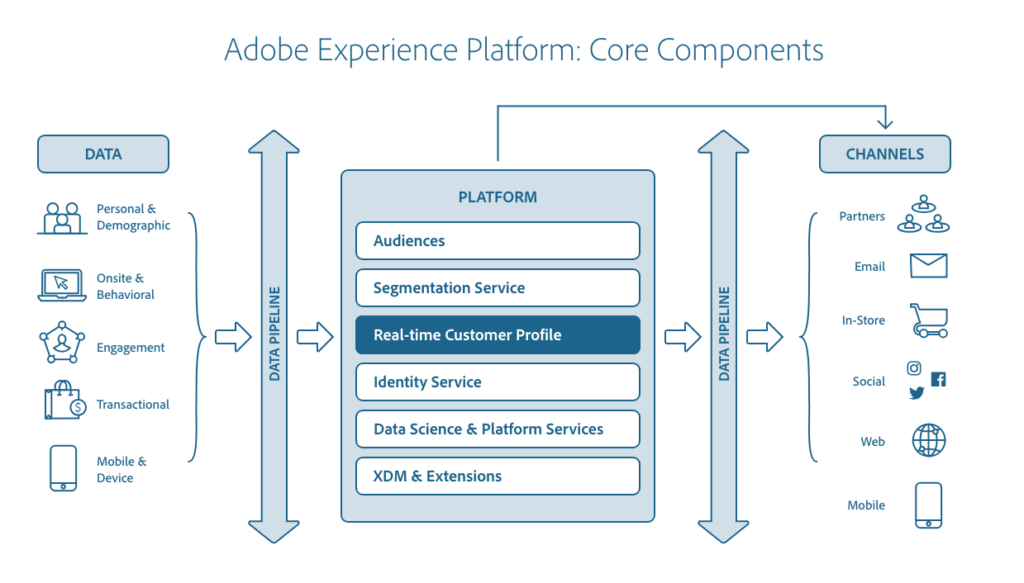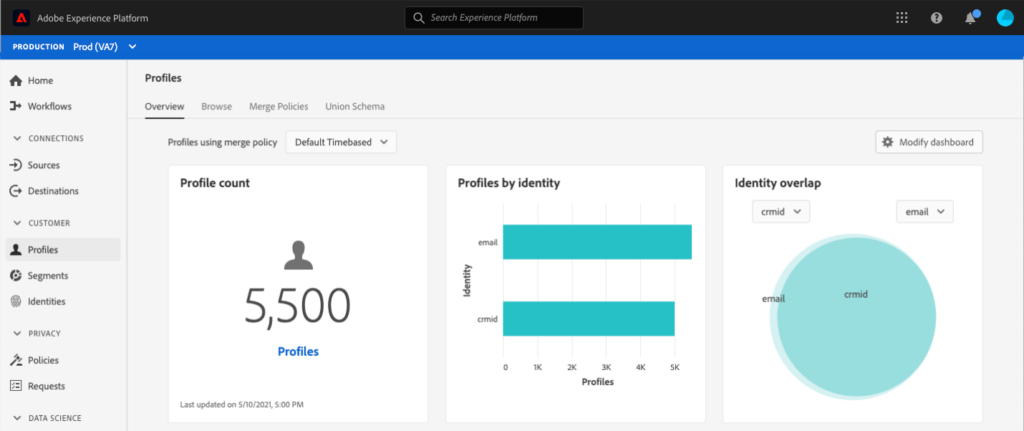Introduction
In my fourth and final blog post on Adobe Experience Platform (AEP), I cover the tool generating massive interest from brands of all industries and sizes, Adobe's Real-time Customer Data Platform. The Adobe Real-time Customer Data Platform (Real-time CDP) is a powerful tool that helps companies combine known and anonymous data from multiple enterprise sources to create customer profiles that can provide personalized customer experiences across all channels and devices in real-time. By leveraging the Adobe Experience Platform, the Real-time CDP can provide marketers with a complete view of the customer journey, allowing for more targeted and relevant marketing initiatives and customer experiences.
The Real-time CDP is an essential tool for companies looking to create a more personalized and responsive customer experience. By utilizing the platform, businesses can better understand customer behavior and preferences and use that information to create targeted marketing campaigns that will resonate with customers. Additionally, the Real-time CDP can help businesses to identify areas where they can improve their customer experience and make the necessary changes to create a more cohesive customer journey.
With Real-Time CDP, you can build profiles and define audiences, as well as derive rich insights while being able to enforce strict data governance policies. The platform connects with many partners and the Adobe Experience Cloud environment for seamless activation of these target groups across channels, including in-person personalized and emails that are tailored just right!
The B2B edition of Real-time CDP is designed for use in business-to-business environments. The different capabilities are enabled within the Adobe Experience Platform ecosystem, which better fits operating with this type of service model than other models like consumer-focused ones. You can get more information about the B2B edition here. This post covers the general capabilities of Real-time CDP.
Outline
1. How does the Adobe Real-time Customer Data Platform work?
2. What are some of the features of the RTCDP?
3. How can businesses use the RTCDP to improve their customer experience?
4. Is the Adobe Real-time Customer Data Platform right for your business?
5. Additional Resources
How does the Adobe Real-time Customer Data Platform work?
The Adobe Real-time Customer Data Platform (Real-time CDP) helps companies combine known and anonymous data from multiple enterprise sources to create customer profiles that can provide personalized customer experiences across all channels and devices in real-time. The Real-time CDP is built on the Adobe Experience Platform, which provides a comprehensive set of capabilities for managing customer data and interactions.

The Real-time CDP can merge data from various sources, including web analytics, social media, CRM systems, purchase history, and demographic data. It then combines the data to create customer profiles. The profiles can be used to personalize the customer experience on websites, emails, and mobile devices. The Real-time CDP also provides pre-built integrations with destination platforms, which allows activation of known and unknown data for multi-channel marketing. Supported advertising destinations include Google Display & Video 360, Google Ads, Snapchat Ads, and more.
A Real-time Customer Profile is like a living, breathing organism. It's made up of the central entity - the primary entity and various other supporting entities- that make these profiles rich and robust! The primary entity of a profile is composed not only of traits and behaviors but also of other entities that allow the segmentation engine to utilize data outside of this primary entity.

What are some of the features of the RTCDP?
Some of the features of the Adobe Real-time Customer Data Platform include:
- Tag Management and Event Forwarding. The events that occur in real-time on any device can be captured and distributed to Adobe applications and other applications with the ability for flexibility. This will improve site performance and customer experience.
- Data Collection and Standardization. Use Adobe’s Experience Data Model (XDM) to unify your known, pseudonymous, and offline customer data. This single uniform model is purpose-built for experience management so that all systems in an enterprise are speaking the same language concerning their customers' experiences.
- Actionable Real-time Customer Profiles. The future of marketing is here! Create, segment, and enrich your real-time customer profiles made up with unified consumer data. Your audience will be powered by AI insights that provide complete targeting options for more personalized campaigns and on-site activation and personalization.
- Consent Management. Stay one step ahead of the game by managing your data across all lines in a single place. The consent-based platform makes it easier to govern how you handle customer information.
- Data Activation. You can activate your audience across different Adobe and non-Adobe destinations with easy-to-use connectors. These connectors build on the promise of 1:1 customer profile orchestration for targeted personalization in real time!
How can businesses use the RTCDP to improve their customer experience?
Businesses can use the Adobe Real-time Customer Data Platform to improve their customer experience in several ways. The Real-time CDP provides a single view of the customer, which can be used to personalize interactions across all channels. It also makes it easy to track the performance of campaigns in real-time, so businesses can make changes as needed. Additionally, the Real-time CDP is built on the Adobe Experience Platform, which provides a comprehensive set of capabilities for managing customer data and interactions. This allows businesses to easily combine known and anonymous data from multiple enterprise sources to create customer profiles that can provide personalized customer experiences.
In a previous blog post, we discussed the advantage of integrating Adobe Target and the Real-time CDP. Using Real-time CDP, you can create contextual, personalized experiences based on your customer profiles that are continuously updated in real-time. The Adobe Target integration allows you to test, optimize, and deliver these experiences across web, mobile, and email. If customers convert on a personalized offer, their profiles can be updated to suppress any advertising related to the purchased product. This ensures the customer isn't receiving non-relevant advertising and allows you to optimize your ad spending to go after customers who have not yet converted.
Is the Adobe Real-time Customer Data Platform right for your business?
The Adobe Real-time Customer Data Platform is a powerful tool for businesses looking to improve their customer experience. It provides a single view of the customer that can be used to personalize interactions across all channels.
Current Adobe customers working with Adobe Audience Manager (AAM) today may be curious to understand the differences between their current capability and the Real-time CDP. In short, the Adobe Real-time Customer Data Platform offers:
- A unified profile for known and anonymous data: The Adobe Experience Platform uses Adobe’s Experience Data Model (XDM) to unify data from multiple Adobe and non-Adobe systems. The XDM also forms the foundation for Adobe’s new Real-time Customer Data Platform.
- A real-time customer profile: The Adobe Real-time Customer Data Platform updates customer profiles so businesses can take immediate action on changes in customer behavior.
- Adobe Sensei-powered insights: The Adobe Real-time Customer Data Platform uses Adobe Sensei, Adobe’s AI and machine learning technology, to provide insights that can improve customer experiences.
- A consent management system: The Adobe Real-time Customer Data Platform includes a consent management system that makes it easy to comply with data privacy regulations.
If you're looking for a platform that can help you deliver personalized experiences in real-time, the Adobe Real-time Customer Data Platform is worth considering.
Additional Resources
There are many additional resources available on the Adobe Experience Platform, including:
- White papers on the Adobe Real-time Customer Data Platform.
- Case studies of how companies are using the Adobe Experience Platform to improve their customer experiences.
- Videos demonstrating the Adobe Experience Platform in action.
Conclusion
The Adobe Real-time Customer Data Platform (Real-time CDP) is a powerful tool that can help businesses improve their customer experience. It combines known and anonymous data from multiple enterprise sources to create customer profiles that can provide real-time personalized customer experiences across all channels and devices. The RTCDP also has several features that can help businesses get the most out of their customer data, including combining data from multiple enterprise sources, creating customer profiles in real-time, and personalizing customer experiences across all channels and devices. Adobe Experience Platform provides businesses with the tools they need to create personalized customer experiences. The Real-time Customer Data Platform is a powerful tool that can help companies to get the most out of their customer data. Thanks for reading!
For more on personalization in Adobe Target, check out this posts on leveraging profile scripts.
Cover Photo by Anna Dziubinska on Unsplash


